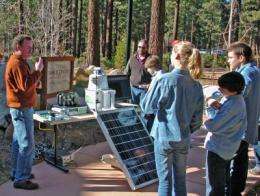New forest fire detection system prototype installed at Lake Tahoe

Graham Kent, Nevada Seismological Laboratory director at the University of Nevada, Reno is leading the installation, testing and maintenance of a novel way to monitor forests fires and other environmental data with the prototype of a new camera system developed by Sony-Europe.
The new 360-degree, solar-powered camera and wi-fi system was installed at Tahoe City, Calif. in anticipation of its debut Dec. 12 via the Internet from Copenhagen during the United Nations Climate Change Conference.
The novel concept, Forest Guard, came from a group of students in Meadow Vista, Calif. who were forced from their homes last year when a forest fire burned 190 square miles of forest in the Northern California region
The early-detection system for wildfires, Forest Guard, will use a closed-circuit television system which sends live pictures of the forest to a computer screen-saver or desktop that is available to internet users around the world.
The network of live cameras will enable citizen firewatchers to quickly raise an alarm if a fire is seen, providing a quick response and thereby reducing potentially huge carbon emissions from a forest fire as well as saving lives and property. Firefighters will also be able to monitor the fire to better deploy resources and warn residents who may be in the path of a fire.
"We've been working on a similar system for several years for scientific research purposes and are grateful to be able to work with SONY on this prototype and get a system installed in the Tahoe-Reno area," Kent said. "The network is ideal for real-time data collection and optimizes the use and expense of the system."
Kent's team, including Ken Smith of the Nevada Seismological Laboratory, Frank Vernon of UC San Diego and Geoff Schladow of the UC Davis Tahoe Environmental Research Center will also use the network's real-time capacity to monitor other environmental systems such as climate, forest fuel moisture, evapo-transpiration, seismic activity and air quality and for research and data collection purposes.
"This camera has serial number 001," Kent said. "We'll be testing and debugging it over the winter in Tahoe City while also doing some interesting science. It's great to have been able to integrate some design features and functions into the system based on our experiences with the 10-year old system in San Diego."
A camera network has been used successfully in Southern California for many years to watch for and monitor forest fires, but without the social netwroking aspect. Kent said the cost of the system is about the same as one or two homes that would be lost in a catastrophic fire and the maintenance of the system for 10 years is equal to about one lost home.
Next summer a network of the wi-fi, solar-powered cameras will be placed on mountaintops surrounding the pristine Lake Tahoe.
The team of six students, whose 'Forest Guard' idea won the global First LEGO League Climate Actions competition in Copenhagen, Denmark in May, impressed Sony executives in Europe so much that they offered to partner with the team to help them develop their idea.
Source: University of Nevada, Reno














